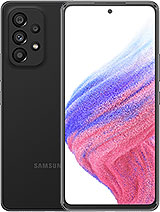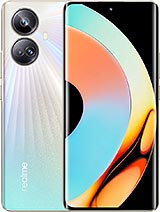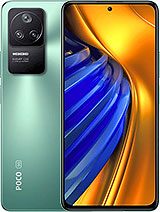Technology
Review of Xiaomi Poco X5 Pro phone, price and specifications
Published
1 year agoon


Price review, camera, screen, design, software, hardware, battery, charging speed and other specifications of Xiaomi Poco X5 Pro.
Review of Xiaomi Poco X5 Pro phone, price and specifications
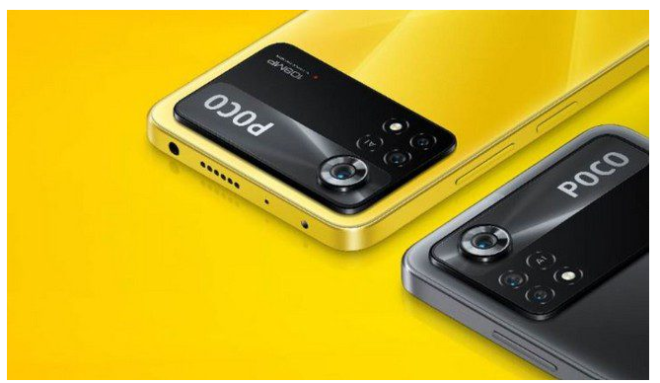

Introduction




Checking the technical specifications of Xiaomi Poco X5 Pro at a glance
Body: 162.9×76.0x7.9mm, 181g; Gorilla Glass 5 front, plastic back, plastic frame; IP53, resistant to dust and water splash.
Display: 6.67 inch OLED, 1B color, 120Hz, Dolby Vision, HDR10+, 500 nits (typ), 900 nits (HBM), 1080x2400px resolution, 20:9 aspect ratio, 395ppi.
Chipset: Qualcomm SM7325 Snapdragon 778G 5G (6nm): Octa-core (1×2.4 GHz Cortex-A78 & 3×2.2 GHz Cortex-A78 & 4×1.9 GHz Cortex-A55); Adreno 642L.
Memory: 128 GB RAM 6 GB, 256 GB RAM 8 GB; UFS 2.2.
OS/Software: Android 13, MIUI 14.
Rear Camera: Wide (main): 108MP, f/1.9, 1/1.52″ 0.7µm, PDAF; Ultra Wide Angle: 8MP, 119˚, 1/4″ 1.12µm; Macro: 2 MP, f/2.4.
Front camera: 16 MP, (wide), 1/3.06 inch, 1.0 µm.
Video recording: Rear camera: 4K@30fps, 1080p@30/60/120fps, 720p@960fps, gyro-EIS. Front camera: 1080p@30/60fps.
Battery: 5000 mAh; 67W wired, PD3.0, QC3+.
Other specifications: Fingerprint reader (mounted on the side). NFC (market dependent); infrared port; 3.5 mm jack; Stereo speakers
Looking at the specifications of the Poco X5 Pro, we can’t see many omissions. The phone has many fan favorite features like dual 5G SIM, NFC, dual speakers, IR blaster and audio jack. And just like other Poco and Redmi phones, this phone is also splash resistant.
However, one feature that has been left out since the Poco X4 Pro is the microSD expansion slot. And there are people who do not take it well.
Unboxing Xiaomi Poco X5 Pro
The Poco X5 Pro comes in a black box that includes a 67W power adapter, a 6A rated USB cable, and a clear protective case.


The X5 Pro also comes with an anti-scratch film already applied to its screen. It’s a smudge magnet and we ditched it after a few days, but many people will appreciate having it.
Checking the design, build quality and handling of the Xiaomi Poco X5 Pro phone
We’ve mentioned that the new Poco X5 Pro comes with an advanced design, though we hope we haven’t gotten your hopes up too high. The new model is quite reminiscent of the Poco X4 Pro and Redmi Note 11 devices, but it has a few changes that we really appreciate.


In fact, the Poco X5 Pro has a familiar shape – flat front and back panels and a smooth bezel, a shape that allows the phone to stand on its own when needed. It is also splash resistant like all recent Xiaomi phones.
The design is slightly faded. In the last generation, there was some sort of holographic gradient going on at the back. The cover is now monochrome and matte, and the glass portion of the camera bump is smaller.
Poco X5 Pro is available in black, blue and yellow colors. And obviously we have the yellow model to review.


Yellow has been a signature color for Poco and it looks good on the Poco X5 Pro.


Like many Poco and Redmi phones, the screen is covered with a sheet of Gorilla Glass 5. The back and frame are made of plastic, both of which have a pleasant matte finish.
Let’s take a closer look at the Poco X5 Pro now.
On the front is an improved AMOLED display with a diagonal size of 6.67 inches. It supports 1080p resolution, HDR10 certification and a 120Hz refresh rate, but the Poco X5 Pro also offers 10-bit color depth and Dolby Vision.


There’s a small hole in the top center, where you’ll find an old 16-megapixel camera.
The screen has relatively uniform edges, which is not always the case in mid-range phones.


















Xiaomi Poco X5 Pro screen review
The Poco X5 Pro has an upgraded 6.67-inch AMOLED display from the Poco X4 Pro and Redmi Note 11. The improved panel supports 10-bit color depth and can display more than 1B colors. And in addition to HDR10, it now supports Dolby Vision content.
The rest of the specs are fairly familiar – 1080 x 2400 pixels resolution or 395ppi, 120Hz refresh rate, 240Hz touch response, wide color support and Gorilla Glass 5 protection.


The display supports 1920 Hz PWM exposure to minimize eye strain in low light conditions.
Poco promises 500nits of normal brightness and 900nits of maximum brightness, and we’re happy to confirm those numbers with our display testing. The minimum white point brightness was 2 nits, which is excellent.
Color accuracy
Poco X5 Pro display supports DCI-P3 wide color space and this is the default setting. Display color options offer three different color models – Vivid (default, DCI-P3), Saturated (DCI-P3 with saturation boost), and Standard (sRGB). You can adjust the color temperature for each mode. There is also a custom mode where you can choose the color spectrum and fine-tune the colors, saturation, hue, contrast, gamma.
The Vivid option (default) faithfully reproduces DCI-P3, and we found it to be fairly accurate, with the exception of bluish-white and gray tones (fixable by selecting a warm color temperature). The standard option corresponds to sRGB and provides accurate rendering, including whites and grays.
refresh rate


Streaming
The Poco X5 Pro comes with Widevine L1 DRM support, and Full HD streaming with HDR10 and Dolby Vision support is available on popular platforms, including Netflix.
Poco X5 Pro battery life review
It is powered by a 5,000 mAh battery and uses the Snapdragon 778G 5G chipset, which has quickly become one of the most popular mid-range phones. We’ve seen a few smartphones like the Xiaomi 11 Lite 5G NE and the Samsung Galaxy A52s match the Poco X5 Pro’s battery life.
The Poco X5 Pro earned an endurance rating of 113 hours, satisfying our call, web browsing, and video playback tests. Standby performance was slightly above average.
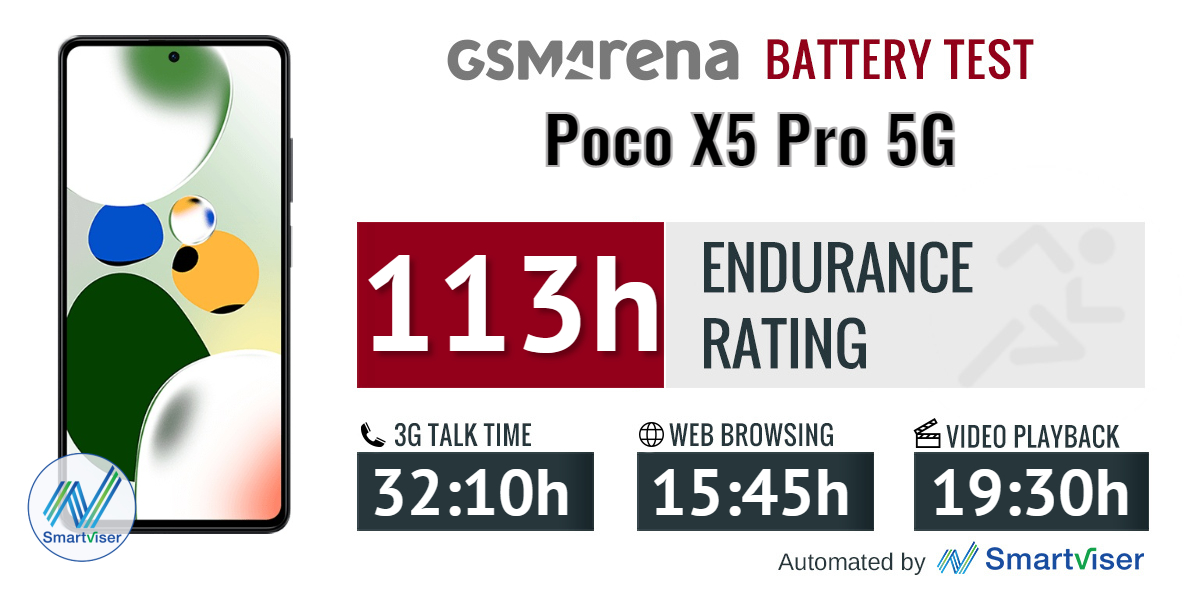

So let’s see how the Poco X5 Pro compares to other phones.


Checking the charging speed of Poco X5 Pro






Checking the speakers of Xiaomi Poco X5 Pro






Xiaomi Poco X5 Pro software review






If you’ve ever used a Xiaomi, the task switcher is also familiar. It shows all your recent apps in two columns.
Split screen as well as floating window are supported. You can minimize some system apps like the calculator to a floating window – when you tap and hold on the app card, you can see if this option is available. Or you can pull down notifications to launch compatible apps in a popup view from within Notification Center.
The regular task switching option with side scrollable cards is not available in Poco Launcher.
MIUI also offers a security app. It can scan your phone for malware, manage your blacklist, manage or limit your data usage, configure battery behavior and free up some RAM. It can also manage the permissions of your installed apps, define the battery behavior of selected apps, and apply restrictions to specific apps only.
And speaking of memory, MIUI 14 offers Memory Extension option which is enabled by default (you can disable it if you want). In our review unit, we can choose between 2GB, 3GB and 5GB of internal memory reserved as RAM expansion. Less important memory blocks should go here.
The sidebar itself is not available. However, its video toolkit is available, and basically includes the entire sidebar functionality, but you have to manually make it available in a set of apps. When enabled, a small icon is visible at the edge of the screen that expands into a menu whenever you swipe on it. From here you run programs in pop-up windows.
Recommended for multimedia applications (such as YouTube, Mi Video, Gallery, etc.). In addition to options for floating windows, it contains shortcuts for Screenshot, Record screen, Cast and Play Video with the screen off that work on YouTube, without the need for a Premium subscription. But, as we mentioned, you need to whitelist the apps beforehand where you want this feature to be enabled.
Checking the performance and benchmarks of the Xiaomi Poco X5 Pro phone
The Poco X5 Pro uses the Snapdragon 778G 5G chipset – a huge upgrade over the Snapdragon 695 5G chipset in the Poco X4 Pro. It is a good 6nm chipset manufactured at TSMC foundries, which has an octa-core processor with four Kryo 670 cores @2.4GHz (based on Cortex-A78) and four Kryo 670 Silver cores @1.8GHz (based on Cortex-A55).
There is an advanced Adreno 642L GPU and an X53 5G modem (up to 3.3 Gbps download speed).
The base configuration of the Poco X5 Pro is now 6GB of LPDDR4X RAM and 128GB of UFS 2.2 storage. You can also opt for 8GB of RAM with 256GB of storage, and this is our review unit. Note that there is no microSD slot.
We’ve already seen a few phones with this chipset and we know it’s pretty good for this class, if not one of the most preferred. And if it weren’t for economic and logistical hurdles until 2022, the SD778G would probably become a widespread SoC in this class.


Anyway, let’s see some benchmarks.
The Poco X5 Pro has one of the fastest processors in the mid-range segment and we really can’t hope for more.








Xiaomi Poco X5 Pro camera review


Camera app


There is a well-featured professional mode where you can change the shooting parameters yourself. Here you can use primary and ultra-wide cameras. You can choose from 4 white balance presets or dial in the light temperature with a slider, a manual focus slider and shutter speed (1/4000s to 30s/0.8s for prime/ultra wide ) and there is ISO control with a range depending on it.
As expected, there are additional modes, including Long Exposure with a selection of different presets – moving crowd, neon trails, oil painting, light painting, starry sky and star trails.
Night mode is available on the main and ultra-wide cameras. Also, Auto Night mode is enabled by default in the settings.
The quality of photos taken during the day
There is an HDR switch on the viewfinder, which has two positions, auto off and on. If left on auto, HDR will turn yellow when the camera app decides to use HDR. This is extremely rare and the difference is a slight dynamic boost in the sky.
The main camera saves 12MP photos by default, and the photos are good, though not great. But let’s not forget that this is a mid-range phone.
Images offer excellent contrast, true-to-life colors, lovely dynamic range, and are clean of noise. Resolved detail is slightly above average, but far from ideal. Complex details (such as foliage) are often smeared (background) or over-sharpened (foreground).
We found those photos to be pretty good for this class – they look great when zoomed in, but at 100% zoom you might find them rather mediocre, as they’re over-processed and look a little artificial.
The quality of photos taken in low light
Poco X5 Pro supports automatic night mode – enabled by default in advanced settings. In theory it should work on both main and ultra-wide cameras, and the camera app should decide when and where to use night mode and exposure time.
Not exactly like other MIUI phones. The main camera used night mode for most of the scenes we shot, although it seemed to occasionally choose a lower exposure than manual in night mode afterwards. Unfortunately, it did nothing for the ultrawide camera.
Photos with the default auto night mode option are easy to love – they’re all well-exposed with great contrast and dynamic range, and color saturation is commendable. Resolved detail is high and noise, even if visible, is not a hindrance.
Sometimes the “Auto Night Mode” gives the wrong indication that it’s doing it or that the exposure time wasn’t long enough – and it messes up the photos and we get a little blurry. That’s why we recommend that you stand still for a second after you’ve finished shooting, and maybe take more than one shot.
Video quality
Review of competitors of Xiaomi Poco X5 Pro


Summary
Indeed, the yellow Poco X5 Pro is eye-catching, but not as attractive as its predecessors. It offers a great OLED with a fast refresh rate of 120 Hz, brightness up to 900 nits and HDR10 and Dolby Vision certifications.
Then comes the excellent Dolby Atmos speakers which are a nice complement to the Dolby display. And we appreciated the long battery life and fast charging.
Of course, the most popular upgrade is the new chipset. The Snapdragon 778G is one of the reasons why the Galaxy A52s is so popular in our conclusion, and we suspect the Poco X5 Pro will follow suit. If only Pocos were IP67 rated like the Galaxy, but we’d guess they’d still do just fine with the unofficial IP53 rating.
The camera department remains the same as the Poco X4 Pro and so is the photo quality. But the new chipset allows for 4K video recording, and it’s pretty awesome. Here is another good news.


Finally, MIUI 14 on top of Android 12 looks exactly like MIUI 13, with none of the obvious new features here. Maybe the underlying optimizations did it, maybe not. But once again most of the new MIUI stuff seems to be reserved for the Chinese MIUI ROM.
The Poco X5 Pro 5G is a decent sequel with some minor flaws, which is why it gets our recommendation. It is one of the best phones in its price range and its specs and solid real-life performance will easily impress most potential buyers.
Why should we buy Poco X5 Pro?
- Nice no-nonsense design, just sticky enough.
- Dolby Vision OLED Excellent, bright, 120Hz refresh rate.
- Great battery life, fast charging.
- Powerful stereo speakers, great sound.
- Great performance, compatible with games, 5G.
- All-round photo and video quality is very good.
- Two 5G SIM cards, Wi-Fi 6, NFC, 3.5 mm jack, IR port. MIUI 14 right out of the box.
Why should we avoid buying Poco X5 Pro?
- The microSD slot is gone, as is the FM radio.
- The quality of the macro camera is poor.
- Quad-Bayer selfie camera.
Source: GSMARENA.COM


You may like
-




What is the difference between CPU and GPU?
-

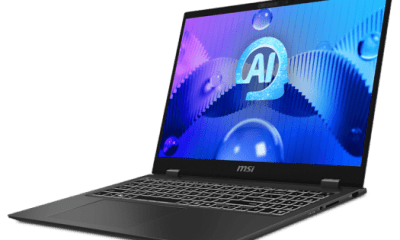


MSI Prestige 16 AI review; A laptop that does not run out of charge
-

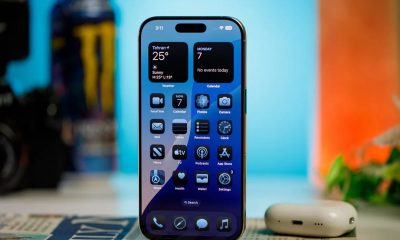


iPhone 16 Pro Review
-




Biography of Geoffrey Hinton; The godfather of artificial intelligence
-




Everything about Cybercube and Robo Van; Elon Musk’s robotic taxis
-




How do we know that our phone is infected with malware?


What is the difference between CPU and GPU?
CPU is a unit for performing the main processes in the computer, which we refer to in this article as the processor . GPU is also a unit for graphics processing with the ability to perform advanced mathematical calculations and machine learning. These units have a similar task, which is information processing .
In fact, the main difference between CPU and GPU is the type of information they process; For this reason, these two cannot be substituted for each other; But using the processor and GPU at the same time provides an ideal combination for the user and brings the best performance to Armaghan.

The graphic processor is located in smart devices such as phones, tablets, or televisions, and in computers it is usually used in the form of a graphics card to take on an important part of the task of processing games, videos, content, and even artificial intelligence, and the CPU also runs computer functional programs such as Manages operating system processes. This unit is called the computer brain. A GPU cannot perform processes as continuously as a CPU and is designed for a completely different performance. On the other hand, the CPU requires more memory for processing than the GPU.
What you read in this article:
-
What you read in this article:
-
What is a central processing unit (CPU) or processor?
-
What is a graphics processing unit (GPU) or graphics processor?
-
Similarities and differences between CPU and GPU
-
What are the advantages and disadvantages of a processor or CPU?
-
What are the advantages and disadvantages of a graphics processor or GPU?
-
Does the game require a GPU?
Computers can be used without a graphics processing unit; Of course, in this situation, you should not expect impressive and powerful graphic performance from this system; But computers without a CPU cannot survive and manage input and output data and run a program. What makes the graphics processor known as an important unit in the computer is the ability to perform parallel processing of this unit, which enables very fast data processing thanks to the number of more powerful cores.
What is a central processing unit (CPU) or processor?
The central processing unit or processor is the brain of any computer that directs the main processes and calculations in a computer system.
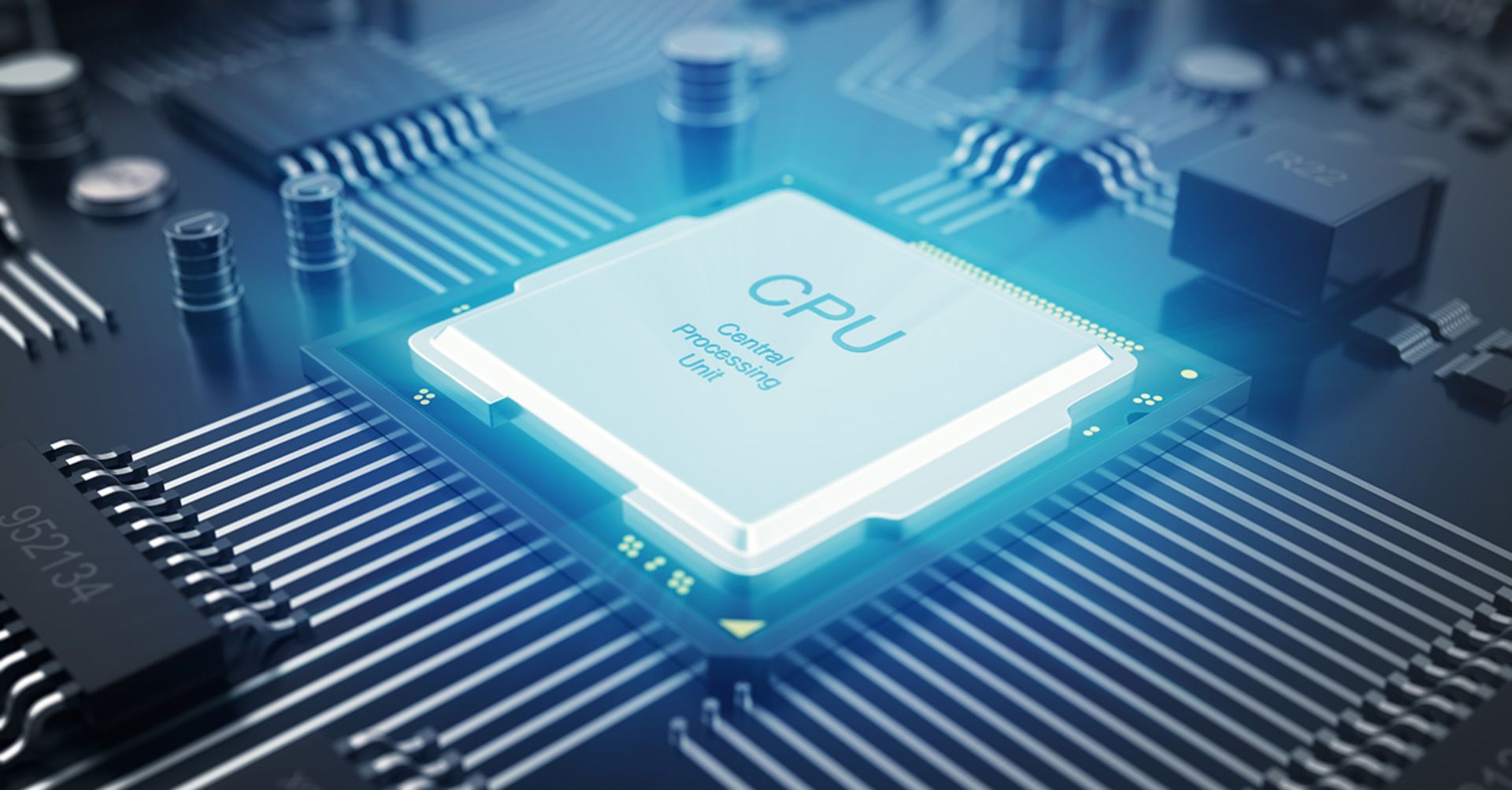
Computers work by processing binary data (zeros and ones) and we need the logical function of the processor to translate this binary data into a language that can be understood by software, graphics, animations and other processes. These logical functions include basic arithmetic and logical functions (AND, OR, and NOT) and input and output operations. For example, when you close or run a program, the processor sends the correct instructions to retrieve data from the hard disk and executes executable code from RAM.
When playing games, the CPU processes the graphics information to display on the display, and when compiling the code, the CPU handles all the calculations and math related to that code. In general, the processor or CPU is the brain of the computer that receives, processes, and calculates information and transfers it to an appropriate path. Each processor consists of the following standard components:
- Core(s): The main architecture of the processor is directly related to its cores, where all calculations and logical processing take place. Cores follow what is called an “instruction cycle”. In this cycle, the instructions are fetched from the memory and decoded through the logic functions of the kernel. At the beginning of development, all processors were single-core, and with the expansion of multi-core processors, the processing power of these units also increased.
- Cache memory: Cache memory is a very fast memory that is located inside the processor or on a board close to it and allows the processor to quickly access the required data. The larger the cache memory capacity of the processor, the more calculations this unit can process per second. For this reason, today, in the configuration of each CPU, different layers of cache memory are placed: L1 (the fastest), L2 and L3 (the slowest). The processor stores information that needs the fastest access in the first layer of cache memory or L1. Level one cache memory (L1) is the fastest and smallest memory and closest to the processor and stores the most important data needed for processing. Data with the next priority of access is stored in L2 and L3. Level two cache memory (L2) or external cache memory has a lower speed and larger volume compared to L1, and L3 cache memory is memory shared by all cores in the processor and has a larger volume and lower speed compared to L1 and L2. The processor moves the data with the lowest priority to the RAM or hard disk and calls them from the main RAM (DDR) when necessary.
- Memory Management Unit: The Memory Management Unit (MMU) controls the transfer of data between the processor and RAM during the instruction cycle process.
- Processor frequency and control unit: each processor performs calculations and processes with a specific frequency. This frequency shows the number of electrical pulses produced in a certain time period (one second) and determines the main method of data processing and transfer and the speed of the processor. The higher the processor frequency, the faster it processes.
An ideal combination of all these components provides conditions for the central processing unit to perform parallel calculations at high speed. With this process, computers run several programs at the same time, display the desktop, provide the possibility of web browsing, etc. In general, it can be said that processors are programmed in such a way that they can switch between operations very quickly in addition to doing one task with the least delay and the greatest speed. Actually, the way of processing in CPUs is serial.
What is a graphics processing unit (GPU) or graphics processor?
GPUs have the same functionality as CPUs and consist of similar components (core, memory, and other components). The most important advantage of GPU over CPU can be considered the ability to simultaneously manage multiple tasks and parallel data processing thanks to its large number of cores. In fact, the most prominent performance that GPUs provide is one of the complex processing tasks that the CPU can hardly handle.
The GPU is a complement to the processor that makes the workload of this unit lighter
An issue that arises in graphics processing is the parallel computation of complex mathematics that are called for graphics rendering. For example, a video game with complex graphics may render hundreds or thousands of polygons on the screen in a certain interval, each of which has a separate movement, color, light, etc. Since processors are not built to handle such workloads, graphics processing units (GPUs) come into play.
GPU cores tend to perform more poorly than CPU cores, and GPUs themselves tend to be less successful at interacting with hardware APIs. As mentioned, GPUs are particularly effective in processing large amounts of data at the same time. Instead of switching between multiple tasks, this processing unit simply receives instructions in batches and processes them in large quantities, and finally displays the desired graphics.
Similarities and differences between CPU and GPU
By comparing the general architecture of processors and GPUs, we can find many similarities between these two units. These units use similar structures in the cache layers and both use a controller for memory and a main RAM. The image below shows the number of cores in a processor and the number of cores in a GPU:
-638bb88e1d67bb742b22ca2e?w=1920&q=80)
An overview of the architecture of modern processors indicates that in this unit, focusing on memory and cache layers, access to memory with low latency is considered the most important factor in processor design. Needless to say, the exact layout depends on the vendor and processor model. Compared to CPUs, GPUs have fewer cache memory layers and less capacity. These units use more transistors for calculations and retrieving data from memory is not very important in them.
The graphics processor has been developed with the approach of performing parallel calculations, and High Performance Computing is one of the effective and reliable uses of parallel processing to run advanced applications. Suppose it has a small number of powerful cores with serial processing capability to perform some kind of heavy calculations.
In such a situation, if we lose one of the cores, the performance of the other two cores will be overshadowed and the overall processing power will be greatly reduced. If we have many and not so powerful cores that can perform several processes at the same time, if one of them is lost, there will be no noticeable change in the processing process and the rest of the cores will continue to work.
-638bb88fa7331cd9fb2ce706?w=1920&q=80)
In addition, the bandwidth of GPUs is much higher than the bandwidth of CPUs and they do parallel processing with a lot of volume much better. As we said, the most important thing about GPUs is that they perform parallel processing well, and if the algorithm or calculations are serial and do not have parallelization capabilities, they do not run at all and slow down the system. CPU cores are more powerful than GPU cores and the bandwidth of this unit is much less than GPU bandwidth.
What are the advantages and disadvantages of a processor or CPU?
Although GPUs are increasingly becoming a tool for high-performance processing today, there are still many important reasons why these units cannot be used as a replacement for CPUs. Some of these reasons are:
- Flexibility in performing different processes: processors can perform other processes and calculations in addition to graphics processing. Serial processing capability allows processors to manage multiple tasks in different contexts; Therefore, a powerful processor can provide more speed than a GPU in normal use.
- Speed in certain processes: CPUs sometimes perform better than GPUs in some situations. For example, the CPU is much faster than the GPU in handling several different types of system operations.
- Accuracy in performing calculations: Processors perform calculations of average mathematical equations more accurately and can more easily control the depth and complexity of calculations. This feature is very important when launching special programs.
- Memory access: Since the cache memory of processors has a large capacity, these units can perform a larger set of linear instructions and, as a result, more complex computing systems and operations.
- Low cost and availability: CPUs are more readily available, more widely produced, and more cost-effective for general and enterprise use.
In addition to the advantages that CPUs offer compared to GPUs, they also have disadvantages:
- Inability to perform parallel processing: CPUs cannot perform parallel processing as well as GPUs, so using these units to process thousands or millions of the same operations will not be efficient.
- Slow evolution process: according to Moore’s law, the development of more powerful processors becomes slower day by day, and their improvement process will be slower every year compared to last year; Of course, the expansion of multi-core processors has somewhat reduced this concern.
- Incompatibility with some systems: Not every system or software is compatible with every processor. For example, applications developed for Intel x86 processors will not run on ARM processors. Of course, this problem is not so troublesome; Because nowadays, most manufacturers use standard sets to develop their software.
Read more: MSI Prestige 16 AI review; A laptop that does not run out of charge
What are the advantages and disadvantages of a graphics processor or GPU?
Today, GPUs have found a growing niche among users and organizations looking to use high-performance computing to solve unique problems. The two main advantages of GPUs compared to CPUs are:
- High throughput: The GPU consists of a large number of cores that can perform the same operation in parallel and process large amounts of data at a very high speed compared to CPUs.
- Massively parallel computing: As we said, CPUs do complex calculations better than GPUs; However, GPUs excel at performing large-scale calculations where many similar operations are repeated.
In addition to the two mentioned advantages, the structure of the GPU allows developers and engineers to use the technology of this unit to run some high-performance applications:
- Bitcoin Mining: The Bitcoin mining process requires a lot of computing power to solve complex cryptographic hashes. The abundant processing power and the relatively low energy requirement of graphics processors have made these units a suitable tool for performing the extraction process, which has recently gained many fans.
- Machine learning: Modern GPUs are used in machine learning. Machine learning is a form of data analysis that automates the creation of analytical models. Basically, machine learning uses data to learn and identify patterns and make decisions independent of human input, and due to the very intensive nature of this system and the need for parallel processing, graphics processors can be considered an essential part of this technology.
Does the game require a GPU?
Having a graphics processor can make a significant change in the user experience of gamers. This unit is used in the presentation of graphic and video content and can have an impressive performance when playing games. In addition, the graphics processor performs the processes at a high speed and thus reduces the workload of the processor.
This means that the overall performance of the computer increases and games run better and smoother. Nowadays, game developers try to make the graphics of their products evoke a real experience for gamers; So it can be said that for better and more natural renderings, the presence of a graphics processor is necessary.
Technology
MSI Prestige 16 AI review; A laptop that does not run out of charge
Published
3 days agoon
29/10/2024

MSI Prestige 16 AI review; A laptop that does not run out of charge
It hasn’t been long since Windows laptop users longed for the long battery life of MacBooks. Most of the laptops we’ve dealt with so far couldn’t last more than three or four hours at most, or if they had longer battery life, they didn’t perform well.
For some time now we have seen moves from Intel, AMD, and recently Qualcomm as Microsoft’s biggest business partners to change the disappointing state of Windows laptops. The emergence of the new Core Ultra, Ryzen AI, and Snapdragon X series is the result of these movements and the starting point to end the nightmare of non-optimization and poor productivity of Windows laptops.
-
Design and build quality
-
Keyboard and trackpad and ports
-
Screen and speaker
-
Hardware, performance, and battery life
-
Special features and facilities
-
Summary and comparison with competitors
About a year has passed since the arrival of the first generation of Core Ultra series laptops, and now there are many laptops that are equipped with different models and SKUs of Miturelic chips; The chips in this and subsequent generations are supposed to restore the concepts of optimality and productivity and give new life to the x86 architecture.
Earlier, we reviewed the Asus Zenbook 14 as one of the first Windows laptops equipped with a Mitorelic chip and its changes in terms of structure, performance and energy consumption. Now we have a 16-inch MSI-style laptop, which has a more powerful battery and while being powerful, it shows new records in terms of charging. Follow MSI Zoomit by reviewing the Prestige 16 AI laptop.
Design and build quality
Thanks to its weight of 1.5 kg, Prestige 16 is very easy to carry and is the lightest laptop among 16-inch laptops on the market after LG Gram and Acer Swift Edge 16. The device has a clean and modern design and is almost considered among the slim laptops. Maybe if the laptop door was flat and less thick, it could better convey the feeling of a compact and so-called Slim laptop.

The thickness of the laptop helps to maintain its strength; So that it does not deviate by pressing the corners. The door opens and closes smoothly and thanks to a durable and high-quality hinge that keeps the display in place when open and does not allow it to slip while moving the device. The proper mass distribution of the product also allows you to open the laptop door easily with one finger and up to an angle of 180 degrees.

MSA says that the body material of Prestige 16 is a combination of magnesium and aluminum to reduce weight and convey a more premium feeling to the user, But the body structure is not as dense as all-aluminum laptops and evokes something between plastic and metal. In addition, due to the injection molding process of the body, the elegance and machining of aluminum laptops cannot be seen; Instead, they show higher durability and strength against external factors (such as impact and scratches).

Prestige 16 laptop is produced only in gray color. A color that shows more dirt on the paper and will probably make you sensitive about the remaining stains and fingerprints on the body; But we must say that fortunately, such an unpleasant phenomenon does not become an issue with this laptop, and compared to aluminum laptops with a dark color, you will see less stains on the laptop door and hand rest.


Prestige 16 doesn’t have anything special except for a few things. The laptop follows forms and sharp lines in its design, especially in the corners. The 16-inch screen is also protected by a plastic frame and not-so-narrow borders. This margin reaches its maximum in the lower part of the screen even with the 16:10 aspect ratio; Of course, in return, it has provided more space for the resting place of the hand as well as the trackpad.

A part of the upper edge of the display is dedicated to a glass strip that, apart from the webcam, hosts several sensors and a thermal camera for facial recognition to meet the minimum hardware requirements of the Windows Hello authentication system, as well as a physical privacy shutter. In addition to this strip, another infrared sensor can be seen on the right side, which is intended for a security feature and we will discuss it further.

Ventilation of the Prestige 16 laptop takes place through holes on the bottom cover and grills that are installed near the edges of the chassis. For this reason, on the left and back edge, grooves for air intake/exit can be seen. Since this laptop uses a fan to cool only its processing chip, the holes and grills on the right side only play the role of keeping the appearance of the laptop.
Keyboard and trackpad and ports
The Prestige laptop uses a full-size island keyboard, which means that the number pad (Numpad) also includes keys. Thanks to the standard dimensions, suitable movement depth, as well as the impact feedback that occurs when the keys are pressed, the typing experience with this keyboard is pleasant and desirable. In addition, the keyboard uses a single-zone white backlight, and the power key also hosts a fingerprint sensor in its heart.


Fortunately, a large space has been allocated to the Prestige 16 trackpad, which is not located in the middle of the laptop and has a tendency towards the left side. Unlike plastic trackpads, Prestige’s glass trackpad does not create much friction with the fingertips; So the finger slides easily on it. The trackpad is also very sensitive to tapping and gestures; But its clicks are dry and firm, and the corners sink in a lot.

The ports are located on the right side and back of the laptop. I tried to deal with it with the idea that the less used ports are probably on the back; But when I checked the left and right side several times for the USB port to install Windows, I noticed that the USB-A port is located on the back of the laptop.



In a situation where most of us make a mistake in finding the right direction to connect the USB-A cable or flash and turn them several times! Now, by placing this port on the back of the Prestige 16, you have to lift the laptop or get up yourself to identify the location of the USB port. The Taiwanese have even placed two USB Type-C ports on the back of the Prestige 16 laptop.
|
Ports on the right |
Back doors |
|---|---|
|
1x RJ45 (1 Gbps) 1x SD card reader 1x 3.5mm headphone/microphone jack |
1x HDMI 2.1 (8K@60Hz/4K@120Hz) 2x Thunderbolt 4 (DisplayPort/Power Delivery 3.0) 1x Type-A USB3.2 Gen2 |
Fortunately, a dedicated port is not considered for charging the Prestige laptop, and due to the support of both USB-C ports for power delivery, you can charge the laptop using adapters compatible with this standard in addition to its own 100-watt adapter.
Screen and speaker
Prestige laptop has a 16-inch screen with a 16:10 aspect ratio, which is produced in two types of IPS and OLED panels with QHD and 4K resolutions; The model I had for review uses an eight-bit IPS panel with a resolution of 2560 x 1600 pixels. Both panels have a 60 Hz refresh rate and there is no news of higher rates.

It seems that the manufacturer is confident enough about the brightness of the display to use a glossy coating despite the strong reflection and reduced readability in bright environments for the display so that the colors look more stunning and pure. Glossy coating also improves contrast and black depth; But the brightness of the display in my measurement did not exceed 335 nits and did not reach the 400 nits announced by the manufacturer.
|
Prestige 16 AI Evo screen performance vs other laptops |
||||||||
|---|---|---|---|---|---|---|---|---|
|
Laptop / test |
White image |
Black image |
contrast ratio |
sRGB |
DCI-P3 |
|||
|
Maximum brightness |
Minimum brightness |
Average brightness |
Native |
cover |
Average error |
cover |
Average error |
|
|
MSI Prestige 16 AI Evo |
335 intentions |
— |
1.43 intentions |
233.85 |
100 |
5.8 |
83.8 |
5.4 |
|
Zenbook 14 |
512 intention (788 nits HDR) |
0.27 nits |
0 intentions |
∞ |
100 |
0.6 |
99.7 |
1.3 |
|
MacBook Air 2024 |
443 intentions |
0.00 nits |
0.67 nits |
661 |
100 |
2.4 |
98.4 |
1.9 |
|
Galaxy Book 3 Ultra |
441 intentions |
4 intentions |
0 intentions |
∞ |
99.6 |
1.9 |
99.8 |
2.3 |
The MSI True Color tool is not available to adjust the monitor’s color profile; Therefore, the default Windows profile is used to display colors. Since the coverage of the sRGB range is complete and exceeds the standard, it can be considered defined in the DCI-P3 space, although this space is not completely covered. In this case, the colors are slightly saturated and tend to be cold to make the content more enjoyable to watch.
The accuracy of the produced colors is not bad for the class of such laptops; But compared to competitors, it doesn’t feel good. In general, the visual experience of the Prestige 16 display is satisfactory, and its brightness is suitable for working in indoor environments, and there is no news of those dead and soulless colors of cheap laptops; But considering its price tag, it could perform better in terms of brightness and color accuracy.

Prestige 16 uses two 2-watt speakers to produce stereo sound, which are not very powerful in terms of bass and volume; But in terms of sound separation, they perform well, and instrumental and vocal sounds are played with good clarity at maximum volume and do not create noise; Of course, using the DTS Audio software, you can customize the default sound equalizer or use ready-made modes to enhance bass, vocals, and treble.
Hardware, performance, and battery life
Prestige 16 is produced in versions with Core Ultra 5-125H, Core Ultra 7-155H, and Core Ultra 9-185H processors; There is also the possibility of a laptop in Studio versions equipped with RTX 4050 and RTX 4060 discrete graphics.
The version under review is powered by a Core Ultra 7-155H chip and has access to 32 GB of dual-channel LPDDR5-6400 RAM integrated with the motherboard. The Prestige 16 storage drive is a PCIe 4.0 SSD with a capacity of one terabyte and provides an additional M2 port supporting the same interface to increase storage space.

The Meteorlake family of chips uses tiles with different fabrication technologies to separate different modules. Apart from the Compute tile, which uses 8 low-power cores and 6 powerful cores with access to a 24 MB cache, the SoC tile has two very low-power cores for light processing, which can show more optimal behavior with 6nm manufacturing technology and prevent A useless conflict of Compute unit.

There are two neural processing engines called Intel AI Boost for artificial intelligence processing in the heart of the chip, But one of the most important features of the Meteoric chip goes back to its graphics unit. The Graphics unit, which is produced with 5nm manufacturing technology, works on the basis of a weakened version of the Xe-HPG architecture called Xe-LPG, which in this version consists of 8 cores, 128 execution units, and 1024 shading units, thanks to the support of features such as Intel XeSS and retracing. Intel has chosen the title Intel Arc for it; Of course, provided that at least 16 GB of RAM is available.
Like other MSI laptops, the Prestige 16 uses the MSI Center software to manage hardware, customizations, and resource controls, and you should refer to this software to change performance profiles. The software provides four profiles including Extreme Performance, Balanced, Silent and Super Battery. Now we will have a brief escape to the performance of the device in the most powerful performance profile when connected to electricity.

By running the Cinebench test, the chip reaches a turbo frequency of 4.8 GHz for a few seconds. In this short period, the maximum power consumption injected into the processor exceeds 65 watts; But gradually it stabilizes almost at the limit of 45 watts. Using the 55-watt version compared to the 28-watt version in the Zenbook laptop improved the processing performance by 13% and made web browsing and daily use 20% faster.
|
Prestige 16 AI performance in benchmarks while plugged in |
||||||
|---|---|---|---|---|---|---|
|
Laptop/benchmark |
Technical specifications |
web browsing |
Performance in graphics |
CPU performance in rendering |
CPU computing power |
GPU computing power |
|
3DMark |
CineBench R23 |
GeekBench 6 |
GeekBench 6 |
|||
|
Speedometer 2.1 |
TimeSpy |
Single Multi |
Single Multi |
OpenCL |
||
|
DirectX 12 |
iGPU GPU |
|||||
|
MSI Prestige 16 AI |
Core Ultra 7-155H Intel Arc GPU (8-Core) |
474 |
3905 |
1842 15145 |
2444 12959 |
35360 — |
|
Zenbook 14 |
Core Ultra 7-155H Intel Arc GPU (8-Core) |
396 |
3453 |
1637 13367 |
2290 12256 |
34889 — |
|
MacBook Air 2024 |
Apple M3 8 core GPU |
680 |
— |
1897 9872 |
3143 2008 |
25845 — |
|
Galaxy Book 3 Ultra |
Core i7-13700H RTX4050 |
396 |
7052 |
1830 14800 |
2591 13261 |
17416 74549 |
|
MacBook Pro 2022 |
Apple M2 10-core GPU |
407 |
— |
1579 8730 |
2556 9540 |
28852 — |
|
MacBook Pro 14-inch 2021 |
M1 Max 24Core GPU |
300 |
— |
1549 12508 |
2378 12239 |
65432 — |
Based on the score of the 3DMark game simulator, the Prestige 16 is also 13% faster than the Zenbook 14 in terms of graphics; But its computing score is not significantly different from the Asus laptop. To understand the efficiency of the graphics that is at the heart of this chip, it can be said that it offers performance equivalent to the RTX 2050 graphics of the laptop version by receiving 28 watts, and in games it is on par with MacBook Air M3.

The Prestige 16 laptop is not designed for gaming, But the output frame rate of some heavy games shows that you can have a good gaming experience even with medium to high graphics settings. For example, the Forza Horizon 5 game with High graphics settings does not have a difficult path to achieve an average frame rate of 43 frames per second, or even Cyberpunk, which achieves a 30 frame rate with Ultra graphics settings and relies on Intel XeSS.
|
Prestige 16 AI performance in games |
|||
|---|---|---|---|
|
Game/Performance |
Clarity |
Graphics settings |
Average frame rate |
|
Forza Horizon 5 |
FHD |
High Intel XeSS Ultra Quality |
43 frames per second |
|
Ultra Intel XeSS Ultra Quality |
28 frames per second |
||
|
QHD |
High Intel XeSS Ultra Quality |
33 frames per second |
|
|
Cyberpunk 2077 |
FHD |
Ultra Intel XeSS Auto |
30 frames per second |
|
Ultra Intel XeSS Quality |
26 frames per second |
||
|
QHD |
Ultra Intel XeSS Auto |
25 frames per second |
|
|
Ultra Intel XeSS Quality |
19 frames per second |
||
By disconnecting the laptop from the outlet, you can play games without much loss of performance. In this situation, Forza runs in the range of 36 to 40 frames. These results are obtained from playing heavy and graphic (AAA) or moderately heavy games, and you can expect higher numbers in more common and lighter games.

Before the introduction of Meteoric chips, Apple Silicon MacBooks were among the few laptops that maintained their agility and agility in battery-dependent mode without impairing the user experience in the slightest; But Meteoric and recently Lunaric chips are dealing with this big weakness of Windows laptops and good progress has been made, so we can say that the performance of the Prestige 16 laptop chip in CPU-oriented processing is only a negligible 2-5% in GPU processing. – The axis is also limited by 10%.
|
Prestige 16 AI operation in plugged and unplugged mode |
||||||||
|---|---|---|---|---|---|---|---|---|
|
profile/parameter |
Speedometer |
GeekBench 6 |
Cinebench 2024 |
3DMark |
Photoshop |
Premiere |
||
|
CPU |
GPU |
CPU |
GPU |
|||||
|
Extreme Performance Plugged |
474 |
2444 12959 |
35360 |
108 868 |
3905 |
6371 |
3089 |
|
|
Extreme Performance Unplugged |
416 |
2308 12137 |
22117 |
102 839 |
3571 |
4641 |
2732 |
|
The drop in laptop performance is worst in everyday laptop use, web browsing, and working with professional software such as Premiere; But still, the maximum effect that the chip receives in this regard does not exceed 13%; Of course, in Photoshop, exceptionally, this distance reaches about 37%, which probably comes from the 60% drop in graphics computing power when the device is disconnected from the power supply.


Fortunately, the cooling fan of the Prestige 16 laptop produces very little noise during heavy processing at the fastest possible speed, and the device itself rarely gets hot. In fact, if the processor is not subjected to a heavy processing load, in normal use it has a temperature between 38 and 45 degrees Celsius, and in this situation, the laptop fan works at a lower speed and there is no sound from it at all; Therefore, you will only notice the sound of the fan during heavy use.


In long-term heavy processing, the device may get a little hot; But it intelligently manages the power and frequency so that the processing process goes to the end without any problems or performance loss. The interesting point is that the processor behaves milder in the battery-dependent mode and at the beginning of the stress test it starts working with power within its thermal design power (TDP) range; In this way, the processor does not face a thermal shock, and starts heating up later, and as a result, it has a more uniform performance.

In the plugged-in mode, more power (around 70 watts) is injected into the processor at the beginning of the process to reach the frequency of 4.8 GHz for a moment and show its highest performance level, then it keeps the power in the range of 50-60 watts for 5 minutes and Finally, after 10 minutes, it fluctuates in the range of 45 watts. Powerful cores also have a lot of ups and downs up to half of the test time, and we see that the processor speed is higher in the unplugged mode.

After approximately 17 minutes, the CPU reduces the frequency of its low-power cores and returns the high-power cores to the 2.8 GHz circuit, which is the behavior that the chip exhibits when running on the battery from the beginning and maintains this state until the end. Under any conditions, the graphic consumes 20 watts until it receives its power from the battery, and the temperature of its hottest point does not exceed 80 degrees Celsius; But in terms of performance, it does not follow the path in a linear and completely stable way.


To provide the necessary power and energy for Prestige 16, MSI has used a 99.9-watt-hour battery, which is the maximum capacity allowed for use in a laptop, and usually, except for the flagships, we have rarely seen batteries with such a capacity in such laptops. From the beginning, it was thought that the combination of the most powerful battery and the presence of an optimized chip, especially in daily use and watching movies, would lead to stunning charging.
|
Prestige 16 AI Battery Life vs Other Laptops |
||||||
|---|---|---|---|---|---|---|
|
Laptop/Test |
Functional profile |
hardware |
Display |
Battery capacity |
Play offline video |
Everyday use |
|
Processor and graphics |
Dimensions, resolution and refresh rate |
watt hours |
720p Video |
PCMark 10 |
||
|
minute: hour |
minute: hour |
|||||
|
MSI Prestige 16 AI |
Extreme Performance |
Core Ultra 7-155H Intel Arc GPU (8-Core) |
16 inches and 60 Hz 2560 x 1600 pixels |
99.9 |
20:00 |
13:05 |
|
Zenbook 14 |
Performance |
Core Ultra 7-155H Intel Arc GPU (8-Core) |
14 inches and 120 Hz 1800 x 2880 pixels |
75 |
17:25 |
9:09 |
|
MacBook Air 2024 |
— |
Apple M3 8 core GPU |
13.6 inches and 60 Hz 1664 x 2560 pixels |
52.6 |
14:13 |
— |
|
Galaxy Book 3 Ultra |
Performance |
Core i7-13700H RTX 4050 |
16 inches and 120 Hz 1880 x 2880 pixels |
76 |
11:00 |
6:21 |
|
MacBook Pro 2022 |
— |
Apple M2 10-core GPU |
13.3 inches and 60 Hz 1600 x 2560 pixels |
58.2 |
26:18 |
— |
|
MacBook Pro 2020 |
— |
Apple M1 8 core GPU |
13.3 inches and 60 Hz 1600 x 2560 pixels |
58.2 |
16:47 |
— |
|
MacBook Pro 14-inch 2021 |
— |
M1 Max 24Core GPU |
14.2 inches and 120 Hz 1964 x 3024 pixels |
70 |
18:14 |
— |
If the screen brightness is set to 200 nits and wireless connections are disconnected, the Prestige 16 laptop can play 720p Zoom video for 20 hours and last for more than 13 hours in daily use, which is a new record not only compared to Windows laptops but also to most MacBooks.
In my tests, when using the laptop for things like web browsing, working with Office, watching photos and videos, and working with Windows File Explorer, the device consumes between 4 and 15 watts of power, which is fine for everyday use and situations like presenting in classes. and meetings, making it a rare and wonderful choice among Windows laptops, moreover, without worrying about Carrying a charger without worrying about performance loss, you can rely on it for one to two days of use.
Special features and facilities
MSI, in collaboration with Tobii, has put together a set of different sensors and cameras for face recognition in order to increase productivity on the top edge of the display. On the other hand, the sensors allow the user to protect his privacy from strangers looking at his laptop screen.

After installing Windows, software called Tobii Experience is automatically installed on the system when the device is connected to the Internet or drivers are installed. Various facilities are available in this software, before using them, you must activate the set of sensors through this tool. For productivity, you can enable various features such as Auto Framing to automatically reposition the image frame by following the subject in video calls. You can also create an avatar of your face and display it in video conferences instead of your real image.


When you get up from the laptop, you can make the laptop screen go dark after a while or the screen won’t turn off until you are sitting in front of the laptop and reading something. Another interesting feature is tracking eye movements, so if two or more monitors are connected to the laptop, you can select a window and look at the monitor you want, leave the window in that area, or change the position of your cursor with eye movement.
Read more: Asus Zephyrus G14 2024 laptop review


Another part of the Tobii Experience software is to increase privacy; Of course, to use these features, the camera and sensors are always on, which may cause privacy concerns and lead to increased battery consumption; But if you are interested, there are options such as blurring the screen if you leave the laptop, or having people around you look at the laptop screen and notify you, and even lock Windows when you leave the laptop. In video calls, you can play an image instead of the webcam image when you are not present.
The Tobii Experience tool provides users with some health solutions and prevention of eye fatigue; For example, it records the time you stare at the screen and your distance to the screen, and if necessary, sends warnings to the user to rest their eyes or maintain a safe distance.

MSI has also equipped the laptop with Intel’s Killer Wi-Fi series modem to enable connection to networks compatible with the new Wi-Fi 7 standard with greater speed and security.
Summary and comparison with competitors
These days, laptops that are powerful enough for daily tasks and specialized tasks such as working with professional, engineering and programming software and that can last at least a day without needing a charger are in high demand. The Prestige 16 laptop is a good choice among 16-inch laptops on the market, with a great battery life and a chip that performs optimally for both everyday use and professional use.
With all the positive features of Prestige 16, there are some flaws such as the placement of important ports such as USB on the back of the laptop. Also, considering the price tag of 80 million Tomans, in this price range, you can find more powerful laptops with OLED display and higher refresh rate, which are convertible and support touch screen.
What do you think about the Prestige 16 laptop? Are the capabilities and features of this laptop attractive to you or would you rather go for another laptop with the same price tag?


iPhone 16 Pro Review
We usually know Apple as a company that refuses to release half-assed products or software features and prefers not to enter a new field at all or to enter with a product that provides a reliable and efficient experience to the user. Accordingly, the iPhone 16 Pro is the most imperfect product in Apple’s history; I will explain further.
-
iPhone 16 Pro video review
-
Camera and Camera Control
-
Ultrawide camera
-
Main camera
-
Telephoto camera
-
Portrait photography
-
selfie camera
-
Performance and battery
-
Design and build quality
-
Display and speaker
-
Summary and comparison with competitors
Apple is marketing the iPhone 16 Pro with a focus on Apple Intelligence and its artificial intelligence capabilities; But now, even to experience Apple’s artificial intelligence half-and-half, you have to wait until the official release of iOS 18.1 in late October, more than a month after the iPhone 16’s launch. There is not even news of the attractive animation of the new Siri; The animation that inspired Apple to name the iPhone 16 event It’s Glowtime.

For those who have been unaware of the technology world since the early months of 2024, I must say that Apple Intelligence is Apple’s answer to Google’s Gemina, Samsung’s Galaxy AI, and even Microsoft’s Copilot. According to Apple Intelligence, Siri is going to be what was promised 13 years ago, during its unveiling; A full-fledged digital assistant that speaks to the user in natural language; Of course, apart from the advanced Siri, capabilities such as creating photos and emojis with AI, text writing and photo editing tools will also be added to iOS.
Note that we have to wait for iOS 18.4 to fully experience Apple Intelligence with all its features; This update will be released in the early months of 2025. iPhone 16 comes with iOS 18 by default; So it is not surprising that Apple lags behind its competitors with such a delay, and the iPhone 16 Pro is not a perfect device either.
Camera and Camera Control
Now that Apple Intelligence is out of the question, and as per Zoomit’s policy, we don’t review a device based on the promise of future updates, let’s leave AI out of the iPhone 16 Pro review headlines and start straight from the part that has changed the most. : Camera or rather, camera button.




While it was said that Apple is working on removing the physical buttons of the iPhone, this year surprisingly, another button was added to the iPhone 16 family; Although Apple insists on calling it Camera Control. Unfortunately, camera control is crude and incomplete both in terms of implementation and capabilities; I will explain further.
As usual with Apple, the camera control has a complex engineering behind its simple appearance. The surface of the control camera is made of sapphire and is surrounded by a stainless steel ring of the same color as the body. Under this surface, there is a precise force detection sensor with haptic feedback along with a touch sensor so that the camera control can simulate the shutter of DSLR cameras and recognize the swipe of the finger on the button surface.

Apple says that by the end of this year, with a software update, it will add a feature to the camera control that will allow the user to focus on the subject by half-pressing the button and record the photo by fully pressing it, just like professional cameras and Xperia phones. On the other hand, after the release of Apple Intelligence, the user will have access to Siri’s image search function with the camera control.
control camera; An interesting idea, but very immature
Currently, with the camera control, you can take photos, record videos, or change camera parameters; Thus, by pressing the button once, the camera application is launched, now if you press the button again, a photo will be taken, and if you hold it, the video will start, and as soon as you lift the finger, the video will stop.
In the camera environment, if you gently press the button twice without lifting your finger, the photography parameters will appear, you can switch between the options by swiping on the button surface, and you can enter the desired parameter settings with another gentle press. Among the photography parameters available are exposure, depth of field, zoom, switching between cameras, Style, and Tone, and we will talk more about the last two in the following.



To be honest, for me and many of my colleagues at Zoomit, it was much easier and more straightforward to touch the screen to navigate through the camera menu than to use the camera controls. Still, after 10 days of working with iPhone 16 Pro, it is very difficult and time-consuming to go to the photography parameters section and swipe to adjust the parameters; For example, it often happens that while swiping to adjust the value of a parameter such as Tone, the phone decides to exit the Tone settings and move between parameters.
One of the problems of the camera control comes back to the firmness of its button; Therefore, when taking pictures with this button, the phone shakes; An issue that may end up blurring the details of photos in the dark.
Apart from the safety of the button, the placement of Camera Control is also not optimal in my opinion; When using the phone in portrait mode, especially with the Pro Max model, you are likely to have trouble and need to use both hands; If you use the phone with your left hand, sometimes your fingers may press the button and disrupt the phone’s functionality.

If Apple fixes the problems and bugs of the control camera, maybe it can be used in two cases; First, during zooming, because you can have more precise control over the zoom level, and second, for faster access to Apple’s new settings for the camera called Style and Tone, which are very useful for photography enthusiasts; Now I will explain the reason.
iPhones usually have their own style of photography; iPhone photos usually have colors close to reality with a relative tendency towards warmth, and there is no mention of saturated and high-contrast colors; Of course, Apple introduced the Photographic Styles feature with iPhone 13 to satisfy the fans of high-contrast photography in the style of Google Pixels by providing different photography styles.
iPhone 16 Pro? Pixel 9 Pro XL or Galaxy S24 Ultra? Which phone has the best camera? The result will surprise you.
With the iPhone 15, Apple adopted a policy that was not very pleasant for the public; In short, in order to use all the capacities of the powerful Photonic Engine with the aim of preserving the details of the shadows and highlights, the iPhone goes a little too far in the implementation of HDR to the point where the colors and shadows lose their power and do not have the previous dramatic sense.
The bad news is that the iPhone 16 Pro follows Apple’s previous policy and, so-called, records the shadows weakly; But the good news is that now with the evolved version of Photographic Styles, you can breathe new life into shadows and colors. With the new version of Photographic Styles, you can change the type of skin color processing and shadows, even after taking photos, you can change the photography style.
Discover your photography style with the iPhone 16 Pro
Before we see the effect of photographic styles on photos, let’s talk about their different modes first. iPhone photography styles are now divided into two general categories: Mood and Undertone; Apart from the standard photography mode, 5 Undertone styles and 9 Mood styles are available. Undertone styles adjust the skin tone of human subjects more than anything else, and Mood styles offer functionality similar to Instagram filters.
Undertone styles are as follows:
- Standard: iPhone’s default photography mode
- Amber: Intensifies the amber tone in photos
- Gold: Intensifies the golden tone in photos
- Rose Gold: Intensifies the pink-gold tone in photos
- Neutral: Neutralizes warm undertones in photos
- Cool Rose: Intensifies cool-toned color in photos






Mood styles are as follows:
- Vibrant
- Natural
- Luminous
- Dramatic
- Quiet
- Cozy
- Ethereal
- Muted B&W
- Stark B&W









All styles can be customized with three new parameters: Palette, Color, and Tone; The Palette parameter changes the range of applied colors, Color adjusts the intensity of color saturation, and most importantly, Tone can change the intensity of shadows and contrast and bring freshness back to iPhone photos.
While the Palette parameter is adjusted with a simple slider, you have to use a control pad to adjust color and tone. Working with this pad is very difficult and boring; Because to change the value of each of the two parameters, you have to put your finger on the head pad and since you have no feeling about the exact location of the finger, it is difficult to change the other parameter by keeping one parameter constant.
The iPhone 16 Pro photography experience is slightly different from the previous generation
If, like me, you don’t feel like messing around with the control pad and slider, you can directly access the styles or the Tone parameter with the camera control button and believe that you can increase the attractiveness of iPhone photos just by changing the Tone; For example, pay attention to the following two photos:
As you can see in the photos above, without changing the styles and simply by reducing the intensity of the tone, both the shadows have returned to the photo, and the black color of Mohammad Hossein’s t-shirt is visible better than before thanks to the improvement of the contrast of the image.
Ultrawide camera
Leaving aside the discussion of photography styles, the iPhone 16 Pro camera itself has undergone several major changes, the most important of which is the upgrade of the telephoto camera sensor from 12 to 48 megapixels; The new sensor uses a Quad-Bayer filter and 0.7-micrometer pixels; Therefore, it seems that the dimensions of the sensor itself are not different from the 1.2.55-inch sample of the previous generation with 1.4-micrometer pixels.
|
camera |
Sensor |
Lens |
capabilities |
|---|---|---|---|
|
Wide camera (main) |
48-megapixel Sony IMX903 Dimensions 1/1.28 inches 1.22 µm pixels Phase detection autofocus Sensor-shift optical stabilizer |
24 mm Aperture f/1.78 |
12, 24 and 48-megapixel photography 4K120 video recording Dolby Vision, ProRes, and Log Portrait photography |
|
Telephoto camera |
12-megapixel Sony IMX913 Dimensions 1/3.06 inches 1.12 µm pixels Dual Pixel phase detection autofocus Sensor-shift optical stabilizer |
120 mm Aperture f/2.8 5x optical zoom |
12-megapixel photography 4K60 video recording Dolby Vision, ProRes, and Log Portrait photography |
|
Ultrawide camera |
48 megapixels Dimensions 1/2.55 inches 0.7 µm pixels Phase detection autofocus |
13 mm Aperture f/2.2 |
12 and 48-megapixel photography 4K60 video recording Dolby Vision, ProRes, and Log Macro photography |
|
selfie camera |
12-megapixel Sony IMX714 Dimensions 1/3.6 inches 1.0 µm pixels Phase detection autofocus |
23 mm Aperture f/1.9 |
12-megapixel photography 4K60 video recording Dolby Vision, ProRes, and Log |
In order for the pixels to capture the right light, the ultrawide camera by default captures 12MP photos by combining 4:1 pixels and achieving 1.4 micrometer pixels; But with the HEIF Max photography format, it is possible to shoot with 48 megapixels, so that the user has more freedom to zoom in on the photos.




As you can see in the images above, the ultrawide 48 megapixel photo of the iPhone is somewhat more detailed in some parts; But it is generally softer than the 12-megapixel model. We also took photos of the same subject with iPhone 16; There is no noticeable difference between the 12 megapixel photos of the two phones.

Ultrawide iPhone 16 Pro camera with 1/25 second exposure

iPhone 16 ultrawide camera with 1/10 second exposure
 Crop ultrawide camera photos in the dark
Crop ultrawide camera photos in the dark
iPhone 16 Pro goes to Night mode and long exposure much less than the iPhone 16 in dark environments; Therefore, sometimes its ultrawide night photos are less detailed than the iPhone 16; For example, in the photos above, the iPhone 16 is exposed for one-tenth of a second; While the exposure of the iPhone 16 Pro was 60% less and equivalent to one twenty-fifth of a second; So it is not surprising that the cheaper iPhone photo is more attractive!
iPhone 16 Pro ultrawide camera photo gallery












The ultrawide camera of the iPhone 16 Pro generally takes attractive photos, But maybe it cannot be considered on par with competitors. The difference in performance with the best in the market is more noticeable in the dark; The iPhone 16 Pro’s ultrawide camera doesn’t appear so amazing in dark environments and records relatively soft photos. To evaluate the performance of the iPhone’s ultrawide camera against the competitors, I suggest that you read the comprehensive article comparing the 2024 flagship cameras.
Main camera
On paper, the main 48-megapixel camera of the iPhone 16 is no different from the previous generation in terms of sensor dimensions and pixels or lens specifications; But Apple calls this camera Fusion and claims that the sensor itself has become faster, and thanks to a new architecture called Apple Camera Interface, image data is transferred from the sensor side to the chip for processing at a faster rate; So now the main camera of the iPhone has the ability to record 4K120 Dolby Vision.
Record stunning videos with 120 frames per second video recording
HDR filming at a rate of 120 frames per second and 4K resolution requires very heavy processing; Because to implement the HDR effect, several 4K frames with different exposures must be compared and aggregated every second. If you have an external SSD and a high-speed USB 3 cable, you can also save 4K120 videos in professional ProRes and log formats, which give you more freedom when editing videos and correcting colors.
4K120 video sample 1
4K120 video sample 2
The 4K120 iPhone 16 Pro videos are very attractive and detailed and bring a wonderful visual experience to Armaghan. Since none of the 4K120 iPhone 16 Pro videos were uploaded properly to the app platform, you must refer to the YouTube links to watch the videos.
Thanks to the faster sensor and Apple’s new interface, 48-megapixel photos with HEIF Max format are recorded almost without pause and at a rate of about 4 frames per second. Like the previous generation, the iPhone combines multiple 12- and 48-megapixel frames, by default, it shoots at 24-megapixel resolution to provide a balanced combination of contrast, color, and detail; Of course, it is possible to take 12-megapixel photos alongside 48-megapixel HEIF Max photos.



 Crop photos of 48, 24, and 12 megapixels
Crop photos of 48, 24, and 12 megapixels
As you can see in the photos above, the 48-megapixel mode improves the details to some extent at the cost of overall softening of the photo and gives you more freedom to zoom into the photo; But the contrast and concentration of its colors are at a lower level than the 24 and 12-megapixel modes. The 24MP photos seem to have a good balance of detail, color and contrast.

iPhone 16 Pro main camera

iPhone 16 main camera

The main camera of the iPhone 16 Pro has recorded a little more detail in the photos above compared to the iPhone 16; But as you can see, the iPhone 16 Pro photo has a lower contrast, its colors are more warm than the iPhone 16, and the black color of Mohammad Hossein’s T-shirt does not match black enough.
iPhone 16 Pro main camera photo gallery
















The photos of the iPhone 16 Pro’s main camera have the same feeling as the iPhone 15 Pro; They are full of details, the colors appear relatively natural, and tend to be a little warm. The iPhone does not artificially remove noise as much as possible; Therefore, even in the dark, it pulls out a high level of fine and intricate details from the subjects. The large dimensions of the sensor allow the iPhone to record 2x high-quality photos by creating a 12-megapixel crop from the middle of the full-sensor image of the main camera.
Telephoto camera
In addition to the renewed ultrawide camera, another big change is the addition of a 5x telephoto camera to the iPhone 16 Pro; Last year, this camera was exclusive to the iPhone 15 Pro Max. The new telephoto camera uses the same 12-megapixel sensor as the previous generation and provides the user with digital zoom up to 25 times.
iPhone 16 Pro telephoto camera photo gallery












The iPhone 16 Pro telephoto camera records 5x high-quality photos; The level of detail and colors of the telephoto camera are very similar to the main camera and match its mood. The telephoto camera also excels in low-light environments and takes good photos in the dark. But as we said in the comprehensive comparison of 2024 flagship cameras, the competitors perform better in this field.

1x photo

Double photo

3x photo

5x photo

10x photo

25x photo
The combination of the iPhone 16 Pro’s 48-megapixel main camera and its 5x telephoto camera allows us to record relatively high-quality zoomed photos in the range of 1-10x; Apart from the 5x optical zoom, the iPhone looks quite satisfactory at 2x and 10x levels.
Portrait photography
The iPhone 16 Pro relies on the main and telephoto cameras for portrait photography and uses the ToF sensor to accurately separate the subject from the background. 1x and 2x portrait photos are recorded with the main camera and 5x portrait photos are also recorded with the telephoto camera.

1x portrait photo

2x portrait photo

5x portrait photo

1x portrait photo

2x photo with natural bokeh

5x portrait photo
The iPhone had a poor performance in portrait photography several years ago, and the iPhone 16 Pro follows the same rule. Portrait photos are detailed and the bokeh effect implementation is gradual and similar to professional cameras. As we saw in the 2024 flagship camera comparison article, the iPhone beats even tough competitors like the Pixel 9 Pro and S24 Ultra in portrait photography.
selfie camera
The selfie camera of the iPhone 16 Pro is no different from the previous generation, and it still captures eye-catching photos with many details and true-to-life colors.


iPhone 16 Pro with all its cameras is capable of recording 4K60 videos with Dolby Vision HDR standard; Of course, you can also choose 24 and 30 frames per second for filming. Videos are pre-recorded with h.265 codec, But it is also possible to switch to the more common h.264 codec.
We shot at 30 and 60 fps and h.265 codecs, and the iPhone 16 Pro recorded very detailed videos in both modes with vivid colors, high contrast, and decent exposure control; If you want to see the video recording performance in competition with other flagships, don’t miss the iPhone 16 Pro vs. Pixel 9 Pro and Galaxy S24 Ultra camera comparison article.
Performance and battery
The next big change to the iPhone 16 Pro comes back to its chip. A18 Pro uses the familiar combination of 2 high-power cores and 4 low-power cores as a CPU, and this unit is accompanied by a 6-core graphics processor and a 16-core neural processing unit. Apple’s new chip is produced with TSMC’s improved 3nm lithography called N3E.
|
Technical specifications of the A18 Pro chip compared to the previous generation |
|||
|---|---|---|---|
|
Specifications/Chip |
A17 Pro |
A18 |
A18 Pro |
|
Central processor |
2 powerful 3.78 GHz cores with 16 MB cache 4 low-power 2.11 GHz cores with 4 MB cache 24 MB system cache |
2 powerful 4.04 GHz cores with 8 MB cache 4 low-power 2.0 GHz cores with 4 MB cache 12 MB system cache |
2 powerful 4.04 GHz cores with 16 MB cache 4 low-power 2.2 GHz cores with 4 MB cache 24 MB system cache |
|
A set of instructions |
ARMv8.6-A |
ARMv9.2-A |
ARMv9.2-A |
|
Graphics |
6-core 1398 MHz 768 shading units Ray tracing |
5-core 1398 MHz 640 shading units Ray tracing |
6-core 1450 MHz 768 shading units Ray tracing |
|
Memory controller |
4 16-bit channels RAM 3200 MHz LPDDR5X The bandwidth is 51.2 GB |
4 16-bit channels RAM 3750 MHz LPDDR5X The bandwidth is 58.6 GB |
4 16-bit channels RAM 3750 MHz LPDDR5X The bandwidth is 58.6 GB |
|
Record and play video |
4K60 10-bit H.265 |
8K24 / 4K120 10-bit H.265 |
8K24 / 4K120 10-bit H.265 |
|
Wireless connection |
Bluetooth 5.3 and Wi-Fi 7 |
Bluetooth 5.3 and Wi-Fi 7 |
Bluetooth 5.3 and Wi-Fi 7 |
|
modem |
X70 modem Download 7500 MB in the UK Upload is 3500 megabits per second |
X75 modem Download 10,000 megabits per second Upload is 3500 megabits per second |
X75 modem Download 10,000 megabits per second Upload is 3500 megabits per second |
|
manufacturing process |
3-nanometer TSMC |
3-nanometer TSMC (Enhanced: N3E) |
3-nanometer TSMC (Enhanced: N3E) |
Apple says it uses new cores in the CPU, which results in 15% faster performance than the A17 Pro and achieves the same level of performance as this chip with 20% less power consumption. Apple claims that the A18 Pro uses more cache memory compared to the A18 chip.
The A18 Pro chip has faster single-core performance than even multi-100W desktop processors.
According to Apple, the 6-core A18 Pro graphics is 20% faster than the previous generation. Apple says the ray tracing accelerator in the new GPU is also a 100% improvement over the previous generation.

The 16-core A18 Pro neural processing unit, like the previous generation, is capable of performing 35 trillion operations; But thanks to the 17% increase in bandwidth between the RAM and the chip, the new NPU performs better than before in real-world applications. The A18 Pro chip is connected to 8 GB LPDDR5x-7500 RAM with a high-speed memory controller.
|
iPhone 16 Pro performance against competitors |
|||||
|---|---|---|---|---|---|
|
Product/benchmark |
chip |
Speedometer 2.1 |
GeekBench 6 |
GFXBench |
|
|
Web browsing experience |
GPU computing power |
CPU computing power |
Game simulator |
||
|
Vulkan/Metal |
Single/Multi |
Aztec Ruins Onscreen/1440p |
|||
|
Vulkan/Metal |
|||||
|
iPhone 16 Pro |
A18 Pro |
572 |
33105 |
3542 8801 |
59 70 |
|
iPhone 16 |
A18 |
554 |
28025 |
3440 8406 |
59 61 |
|
iPhone 15 Pro |
A17 Pro |
475 |
27503 |
2960 7339 |
59 46.8 |
|
Piura 70 Ultra (Performance Mode) |
Kirin 9010 |
235 |
1528 (Failed) |
1452 4494 |
32 30 |
|
Pixel 9 Pro |
Tensor G4 |
221 |
6965 |
1945 4709 |
70 44 |
|
Galaxy S24 Ultra |
Snapdragon 8 Gen 3 for Galaxy |
240 |
17012 |
2262 7005 |
75 81 |
iPhone 16 Pro is noticeably faster than current Android flagships; The difference of about 60% in single-core CPU performance with the Galaxy S24 Ultra clearly shows how fast the iPhone 16 Pro appears in everyday use.
Apple’s 2024 flagship dictates its 95% advantage over a rival such as the Galaxy S24 Ultra when using the GPU for calculations such as blurring the background of photos and face recognition; However, in the rendering of games, the advantage is still with the Galaxy and the Snapdragon 8 generation 3 chip.
|
The performance of the neural processing unit of the iPhone 16 Pro against competitors |
|||
|---|---|---|---|
|
phone/parameters |
framework |
intermediary |
Single count accuracy score (FP32) |
|
iPhone 16 Pro |
Core ML |
Neural Engine |
4647 |
|
iPhone 15 Pro |
Core ML |
Neural Engine |
3862 |
|
Piura 70 Ultra |
TensorFlow Lite |
NNAPI |
235 |
|
Pixel 9 Pro |
TensorFlow Lite |
NNAPI |
347 |
|
Galaxy S24 Ultra |
TensorFlow Lite |
NNAPI |
477 |
The neural processing unit of the iPhone 16 Pro outperforms the Galaxy S24 Ultra in the GeekBench AI benchmark by an astronomical 870%; Now we have to wait until the release of Apple’s artificial intelligence capabilities to see if such a difference is reasonable or just a bug in the benchmark software.
Like the previous generation, Apple sells the iPhone 16 Pro in versions of 128, 256, 512 GB and 1 TB with NVMe storage; While the base model of the iPhone 16 Pro Max uses 256 GB of storage space. Benchmarks show that the storage speed of the iPhone 16 Pro is no different from the previous generation.
|
iPhone 16 Pro storage speed compared to competitors |
||
|---|---|---|
|
phone model |
Sequential reading rate |
Sequential write rate |
|
iPhone 16 Pro |
1636 megabytes |
1340 megabytes |
|
iPhone 15 Pro |
1652 MB UK |
1380 megabytes |
|
Pixel 9 Pro XL |
1350 megabytes |
171 megabytes |
|
Galaxy S24 Ultra |
2473 megabytes |
1471 megabytes |
If we leave the numbers aside, we will face the fact that the feeling of using the iPhone 16 Pro in everyday use is not much different from the iPhone 15 Pro or even the iPhone 14 Pro. The performance gap between the new iPhone and the previous generations is the reason that the phone can still provide good performance with the standard of a few years later, and of course, it can handle the heavy processing of Apple Intelligence.
Apple says that with the changes made in the internal structure of the iPhone 16 Pro; Including the metal shell of the battery (pro model only), the phone can now perform up to 20% more stable in heavy usage. This performance stability improvement is felt to some extent; The phone does not get hot while playing graphic games and its performance drops less than before; In the Zomit stability test, the iPhone 16 Pro dropped less than the Galaxy S24 Ultra and the previous generation; The maximum temperature of his body reached 47 degrees Celsius.
In order to measure the performance stability of the iPhone 16 Pro in applications other than playing heavy games, we went to the CPU stress test; This test involves all CPU cores for 20 minutes and at the end shows what level of performance capacity the CPU provides after heating up under heavy processing load.

In our tests, the iPhone 16 Pro was able to provide 84% of its performance level to the user after 20 minutes; Therefore, the iPhone probably rarely lags and drops frames during very heavy use. In the CPU stress test, the body of the device reached about 45 degrees Celsius.
This year, Apple has increased the battery capacity of the iPhone 16 Pro and 16 Pro Max by about 10%; This issue, along with the A18 Pro chip’s excellence, makes the new flagships have very good charging; In such a way that Apple considers the iPhone 16 Pro Max as “the best iPhone in history in terms of charging”.

Cupertino residents announce the charging time of the new iPhones with the duration of video playback and say that the iPhone 16 Pro has 4 hours more charging time compared to the previous generation with 27 hours of video playback. Zomit tests also show 26 hours and 5 minutes of charging time for the new iPhone, which is more or less consistent with Apple’s claim.
|
iPhone 16 Pro battery life against competitors |
||||
|---|---|---|---|---|
|
Product/benchmark |
Display |
battery |
Play video |
Everyday use |
|
Dimensions, resolution, and refresh rate |
milliampere hour |
minute: hour |
minute: hour |
|
|
iPhone 16 Pro |
6.3 inches, 120 Hz 2622 x 1206 pixels |
3582 |
26:05 |
— |
|
iPhone 15 Pro |
6.1 inches, 120 Hz 2556 x 1179 pixels |
3274 |
21:11 |
— |
|
iPhone 15 Pro Max |
6.7 inches, 120 Hz 2796 x 1290 pixels |
4441 |
24:43 |
— |
|
Pixel 9 Pro XL |
6.8 inches, 120 Hz 2992 × 1344 pixels (Native) |
5060 |
25:00 |
13:25 |
|
Piura 70 Ultra |
6.8 inches, 120 Hz 2844 x 1260 pixels |
5200 |
25:00 |
17:00 |
|
Galaxy S24 Ultra |
6.8 inches, 120 Hz 3088 x 1440 pixels |
5000 |
27:41 |
14:05 |
Another change of the iPhone 16 Pro goes back to increasing the charging speed; Apple’s new flagship now supports wired charging with a power of 30 watts, and if the same charger is connected to the Magsafe wireless charging pad, the wireless charging power reaches 25 watts, which, according to Apple, can charge the battery from zero to 50% within 30 minutes.
Very good charging and beyond the last generation
Although the wired charging speed of the iPhone 16 Pro has increased from 20 to 30 watts; again, it takes about 100 minutes to fully charge the battery; Because both the battery capacity has increased by 10%, and the iPhone charges between 85 and 100% at a very low speed; Even with the optimal battery charging function turned off, the phone needs about 35-40 minutes to complete the remaining 15% of the battery capacity.
Design and build quality
Leaving aside the fundamental and significant changes of the iPhone, what you will notice at first glance is the increase in the size of the phone, especially in the iPhone 16 Pro Max, and the narrowing of the edges around the screen.

iPhone 16 Pro and Pro Max use 6.3 and 6.9-inch screens with an increase of 0.2 inches in screen diameter compared to several previous generations; So it is not strange that the physical dimensions and weight also increase; Both phones are about 3 mm longer and 1 mm wider and 12 and 6 grams heavier, respectively; Therefore, the increase in the weight of the iPhone 16 Pro is more significant, and the 16 Pro Max sits worse in the hand than before and requires constant two-handed use.

The borders around the display have become noticeably narrower; Now, around the screen of the iPhone 16 Pro, a border with a thickness of a little more than one millimeter (1.15 millimeters to be exact) is covered; While the thickness of the edges of the iPhone 15 Pro is about 1.5 mm, and it reaches more than 2 mm for the iPhone 16; Of course, you should pay attention that by putting the cover on the phone, the narrowness of the edges is less noticeable.


Another change in the appearance of the iPhone 16 Pro is the addition of the Desert Titanium color option to the device’s coloring and the removal of the Blue Titanium option. The new color is more similar to cream with a golden frame; But unfortunately, we didn’t have this color to review. Other color options are limited to neutral and understated Black Titanium, White Titanium, and Natural Titanium.

The design of the iPhone 16 Pro is no different from the previous generation in the rest of the parts; We see the same flat titanium frame with flat glass panels on the back and front of the phone, which are mounted with high precision and form a solid structure with IP68 certification. Unlike the iPhone 16, there has been no change in the painting process of the back panel and the arrangement of the cameras, only the screen cover has been upgraded to the third-generation ceramic shield, which, according to Apple, is twice as strong as the previous generation.

We talked about Camera Control and its not very ergonomic location on the right side of the frame at the beginning of the article. Apart from this new button, the rest of the buttons are the same as the previous generation, the volume control buttons and Side button are in the right place and provide very good feedback, and the Action button, like the previous generation, allows you to personalize it.
Read more: Reviews of iPhone 14 Plus, price and technical specifications
Display and speaker
Finally, another not-so-variable part is the iPhone 16 Pro display, which uses the same 120 Hz OLED panel with LTPO technology; Of course, this year, due to the 0.2-inch increase in the diameter of the screen, its resolution reaches 2622 x 1206 pixels with a very good density of 460 pixels. As before, the display supports HDR standards including HDR10 and Dolby Vision; Therefore, like a few generations ago, we are either with a 10-bit panel or 8-bit + FRC.

Thanks to the LTPO technology, the iPhone 16 Pro display can change the refresh rate of the display between 1 and 120 Hz depending on the type and movement rate of the content, so that the phone can display smooth and smooth animations, and match the frame rate of games and videos. Do not damage the battery charging.
|
iPhone 16 Pro display performance against competitors |
|||||||||
|---|---|---|---|---|---|---|---|---|---|
|
Product/Test |
Minimum brightness |
Maximum brightness |
contrast ratio |
sRGB |
DCI P3 |
Adobe RGB |
|||
|
manual automatic |
local |
cover |
Average error |
cover |
Average error |
cover |
Average error |
||
|
iPhone 16 Pro |
1.35 |
1044 1950 (HDR) |
∞ |
99.7 percent |
0.98 |
— |
— |
— |
— |
|
iPhone 15 Pro |
2.21 |
1052 1947 (HDR) |
∞ |
99.7 percent |
1.0 |
— |
— |
— |
— |
|
iPhone 15 Pro Max |
2.15 |
1041 1950 (HDR) |
∞ |
99.7 percent |
0.9 |
— |
— |
— |
— |
|
Pixel 9 Pro XL |
4 |
1300 2650 (HDR) |
∞ |
97.2 percent (Natural) |
1.1 |
81.6 percent (Adaptive) |
3 |
— |
— |
|
Piura 70 Ultra |
2.5 |
740 1500 (HDR) |
∞ |
99.7 percent (Natural) |
1.9 |
79.7 percent (Vivid) |
5.3 |
— |
— |
|
Galaxy S24 Ultra |
0.7 |
914 2635 (HDR) |
∞ |
102 percent (Natural) |
3.5 |
81.8 percent (Vivid) |
4.4 |
— |
— |
Apple says that the iPhone 16 Pro display, like the previous generation, supports the wide color space of P3, achieves a brightness of 1000 nits in manual mode, and its maximum brightness reaches 2000 nits in automatic mode or during HDR video playback; But the important difference between the iPhone 16 Pro panel and the iPhone 15 Pro comes back to the minimum single-purpose brightness.
Zoomit measurements confirm Apple’s claims about the iPhone’s brightness; We measured the iPhone 16 Pro’s minimum brightness at 1.35 nits, which is significantly lower than the previous generation’s 2.15 nits; But the maximum brightness in manual mode and while displaying HDR videos is no different from the iPhone 15 Pro and is equal to 1044 and 1950 nits, respectively. It goes without saying that the iPhone 16 Pro achieved a brightness of 1296 nits in automatic mode while displaying SDR content (uses other than HDR video playback); But probably exposed to strong ambient light, it can approach the same range of 2000 nits.

iPhone 16 Pro uses stereo speakers, the main channel of which is located at the bottom edge of the frame, and the conversation speaker also plays the role of the second channel. Maybe the volume of the iPhone does not reach the level of competitors such as Pixel 9 Pro or Galaxy S24 Ultra, But the output quality of the speakers is at a higher level; The iPhone’s sound is clearer and its bass is much stronger than its competitors.
Summary and comparison with competitors
If we assume that the government will finally act rationally and start working on the iPhone registry, in this situation, it is not very logical for iPhone 15 Pro and even iPhone 14 Pro users to buy the iPhone 16 Pro with a few 10 million additional costs; Unless the 5x telephoto camera (for iPhone 15 Pro and both 14 Pro models), 15-30% faster chip performance, or Apple Intelligence (for iPhone 14 Pro users) is critical to them.
Users of iPhone 13 Pro or older models have more reasons to buy the iPhone 16 Pro; Better charging, more RAM, a more efficient camera, a brighter screen with Dynamic Island, a faster chip, and perhaps finally artificial intelligence capabilities, can all justify spending money to upgrade from the iPhone 13 Pro to the 16 Pro.
If the ecosystem is not a limiting factor for you, the Galaxy S24 Ultra, even a year after its launch and at a much lower price, offers you more or less the same experience promised by Apple Intelligence with Galaxy AI, and in most cases, in terms of photography and videography, it is on par with the iPhone 16 Pro and even better than It appears.
Naturally, we could not check the competitive advantage of the iPhone 16 Pro; Apple Intelligence is the focus of Apple’s marketing for this phone; But to experience all its capabilities, we have to wait until early 2025; However, a significant part of these features will be available on the iPhone 15 Pro with basically the same experience.

iPhone 16 Pro is a very attractive phone; But at least in the first month of its release, it is not in line with Apple’s philosophy; We know Apple as a company that provides mature and efficient functions and features to the user from the very beginning; But apparently, in the age of artificial intelligence, we have to get used to rudeness and delays; First it was the turn of Google, Microsoft and Samsung; Now Apple.


What is the difference between CPU and GPU?


Maybe the Earth is not doomed by the death of the sun


A look at the structure of the eye and the mechanism of vision


MSI Prestige 16 AI review; A laptop that does not run out of charge


Migraine: symptoms, prevention and treatment


The new version of Copilot was unveiled; Microsoft artificial intelligence


How to solve the problem of slow charging of the Android phone?


Why does Everest get higher every year?


Everything about Cybercube and Robo Van; Elon Musk’s robotic taxis


The wonderful world of ultrasound
Popular
-



 Technology1 year ago
Technology1 year agoWho has checked our Whatsapp profile viewed my Whatsapp August 2023
-



 Technology1 year ago
Technology1 year agoSecond WhatsApp , how to install and download dual WhatsApp August 2023
-



 AI2 years ago
AI2 years agoUber replaces human drivers with robots
-



 Technology1 year ago
Technology1 year agoHow to use ChatGPT on Android and iOS
-



 Technology1 year ago
Technology1 year agoThe best Android tablets 2023, buying guide
-

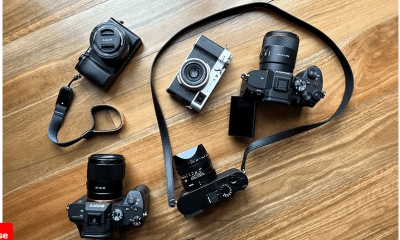

 Technology1 year ago
Technology1 year agoThe best photography cameras 2023, buying guide and price
-



 Humans2 years ago
Humans2 years agoCell Rover analyzes the inside of cells without destroying them
-



 Technology1 year ago
Technology1 year agoHow to prevent automatic download of applications on Samsung phones






























































































































































